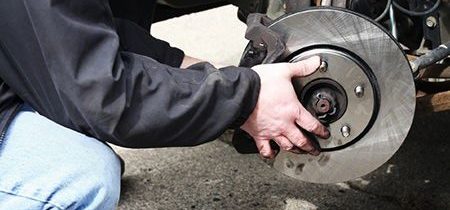Nothing is more important than your car’s ability to efficiently slow down and stop itself. When your brake pads aren’t working properly, you’re putting yourself and your passengers in danger. However, determining if your brake pads need to be changed and changing them is easy if you follow these few steps.
- Tire iron
- Car jack
- Jack stand
- Wrench
- Brake fluid
Step 1 – Determining if Your Brake Pads Need to Be Changed
Find Your Brake Pads
First, you must check your brake pads to see how much they are worn. Look at the brake pads from outside of the front tire. On many vehicles, if you look through the openings on the outer part of the wheel assembly, you can see the pads easily.
Check the Pads
Next, check the depth of the pad. If it’s less than 1/4 inch, you should change the pads soon. If the brake pad’s depth is less than 1/8 inch, you must get them changed right away, so that you don’t damage the rotor.
In addition, if you hear a whining, screeching, or squeaking sound when driving, you should get your brake pads changed.
Step 2 – Preparing Your Car
Once you’ve determined that you need to change your brake pads, block the rear wheels. This will prevent your vehicle from rolling when you raise the car with a jack. Then, put the car in “park” and set the parking brake.
Step 3 – Lifting the Car Up
Using a tire iron, loosen the lug nuts on the wheels. Loosen them just enough so that they are free and easy to turn with the tire iron. Then, slip the jack under the car, using a jack stand for safety. Raise the front axle off the ground. Put your jack stands under each axel, and lower the car onto the stands.
Step 4 – Removing the Parts
Focus on changing one side of brake pads at a time. Remove the lug nuts and the wheel, and then remove the bolts that hold the caliper in place. Slide the caliper away from the rotor. You will see the brake pads. Move the piston back to its “full open” position. Doing this will bring the braking system back to the original position to accommodate the new brake pads.
If your pads are broken, you must repair them. Whether you have a professional repair them or do it yourself will likely determine onhow much money you want to spend.
Step 5 – Installing the Pads
Next, remove the old brake pads from the caliper. They should easily slide out, but if they don’t, you can use a pry bar. Then, put the new brake pads on.
Lubricate the New Pads
Lubricate the new brake pads on the back of the pads, the side that does not come in contact with the rotor, with a high-temperature brake grease. This will prevent unnecessary screeching and noises when you apply your brakes.
Finally, reassemble the braking system in reverse order from the way you disassembled it in the beginning.
taken from- http://www.doityourself.com/stry/how-to-change-brake-pads

